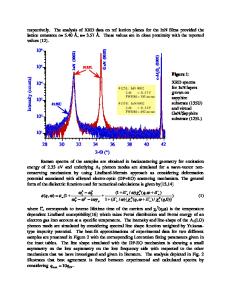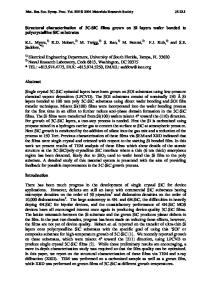Structural Properties of 3C-SiC Layers Grown on Si Substrates by Electron Cyclotron Resonance CVD Technique
- PDF / 186,151 Bytes
- 6 Pages / 612 x 792 pts (letter) Page_size
- 81 Downloads / 396 Views
STRUCTURAL PROPERTIES OF 3C-SiC LAYERS GROWN ON Si SUBSTRATES BY ELECTRON CYCLOTRON RESONANCE CVD TECHNIQUE F. Giorgis1,*, A. Chiodoni1, G. Cicero1, S. Ferrero1, P. Mandracci1, C. F. Pirri1, G. Barucca2, L. Calcagno3, G. Foti3, P. Musumeci3, R. Reitano3
1
INFM and Physics Dept., Polytechnic of Torino, C.so Duca degli Abruzzi 24, I-10129 Torino (Italy) 2 INFM and Materials Science Dept., University of Ancona, Via Brecce Bianche, I-60131 Ancona (Italy) 3 INFM and Physics Dept., University of Catania, C.so Italia 57, I-95129 Catania (Italy)
ABSTRACT In this work we mainly report on the analyses of polycrystalline silicon carbide films grown by Electron Cyclotron Resonance Chemical Vapor Deposition (ECR-CVD) on Si (100) and Si (111) substrates. Structural properties of the films have been analyzed by X-ray diffractometry, transmission electron microscopy and micro-Raman spectroscopy. Samples deposited with optimized deposition conditions, show a polycrystalline columnar structure with lateral crystal dimensions ranging from 300 up to 1400 Å and an orientation close to that of the Si substrates.
INTRODUCTION Despite silicon carbide has been an industrial product for over a century, it is only in the last two decades emerging as the semiconductor of choice for high-power, high temperature and high-radiation environments. This is due to its large breakdown field, high electron saturated drift velocity, good thermal conductivity and noticeable radiation hardness [1]. Among the several SiC polytypes, 3C-SiC (known also as β-SiC) is interesting since, unlike the other ones, it can be grown on Si substrates [2,3]. On the other hand, problems such as lattice and thermal expansion mismatching between the two materials have to be solved. A large number of growth techniques have been applied in order to produce large area, low cost and high quality material. Recently the attention has been focused on microwave assisted plasma techniques and in particular on electron cyclotron resonance chemical vapor deposition (ECR-CVD) [4,5]. Advantages of ECR-CVD technique include the control of ion bombardment on film surface, high plasma density and high electron temperature which are capable to produce a noticeable efficiency in the dissociation of the gas precursors. In this work we performed structural investigations on polycrystalline β-SiC films grown by ECRCVD using a gas mixture of H2+SiH4+CH4. Both Si (100) and Si (111) wafers were used as substrates with temperatures ranging from 930 up to 1050°C. *
Author to whom correspondence should be addressed. E-mail: [email protected]
H5.9.1
SAMPLES PREPARATION AND EXPERIMENTAL DETAILS Polycrystalline SiC films have been deposited in an ECR-CVD system with the following conditions: H2 flow rate 100 sccm, SiH4 and CH4 flow rate of 0.72 sccm, pressure of 25 mTorr, microwave power of 720 W at 2.45 GHz and substrate temperature in the range 930-1050°C. The substrates were 4’’ (100) and (111) silicon wafers held at a distance of 20 mm from a BN heater which is able to reach temperatures up
Data Loading...










